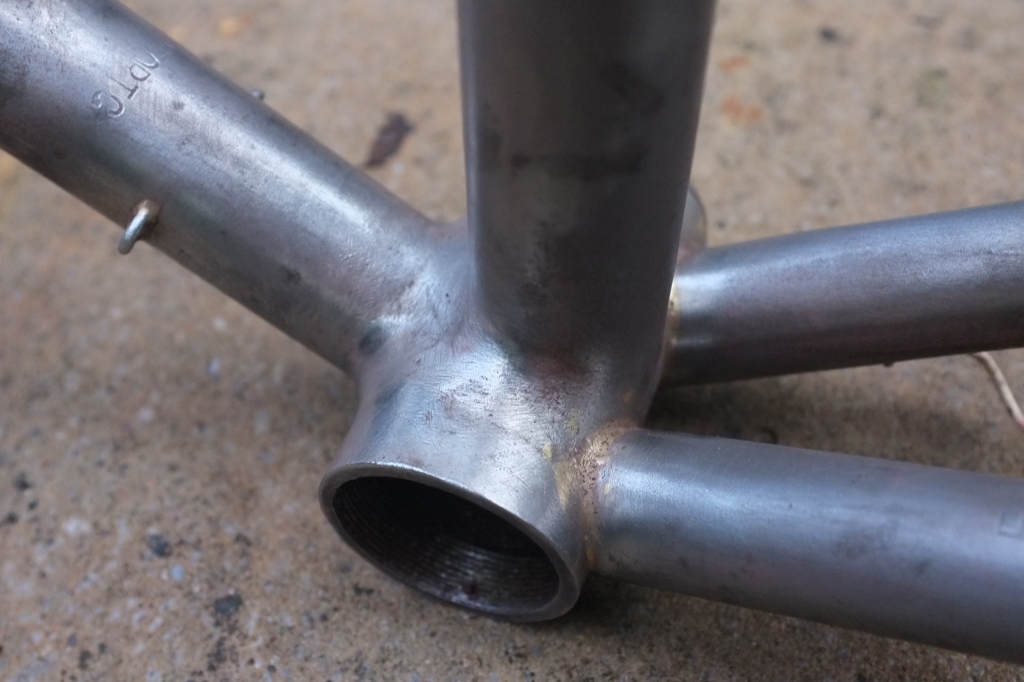I try to resist buying bicycles which are not in original finish because their treatment poses all sorts of questions and dilemmas. As regular readers will know, I am not keen on ‘restoring’ bicycles. I’ve been looking for a Routens for a few years now, but the top models rarely come up for sale. By ‘top model’ I mean that it should be constructed from lightweight tubing, have the typical Routens fork crown, the Routens cable operated front derailleur, and front and rear racks. It should also be fitted with all the best alloy components of the time.
This tourer from the ‘Golden Age’ fits the bill in all respects except for the lack of original finish. The seller described the bike as being in original paint, but it clearly wasn’t, and I based my bid on that being the case. The builder, Jo Routens, was a Grenoble based constructeur. He was a very fine rider and won a number of competitive randonneur events including the Paris-Brest-Paris. He set up shop with his business partner Hugonnier in 1945. The partnership was dissolved in 1952 after which Routens continued under his own name. The Routens company still exists in Gières, on the outskirts of Grenoble.
The design of his bicycles was clearly influenced by the designs of the Lyonnais builders Reyhand and Charrel. Construction is nearly always lugless, with the top of the seat stays joining the top tube in front of the seat tube. Rear brake cable routing through the seat tube is another Routens speciality.
I tested a few parts of the frame and found that there was no original paint under the nasty respray. I then stripped the frame using a citrus based paint stripper which is very pleasant to use, since you don’t need to use gloves, and the residues can be disposed of without any toxicity. Once the paint was softened, I used steel wool and automotive finishing abrasive pads to remove all remaining traces. The mudguards had also been painted with blocks of colour and here I discovered the original finish beneath the new paint. It was chocolate brown ‘Lyonnais’, with gold lining. The bicycle is almost identical in specification to this one on the Tonton forum, and it looks like the finish was also very similar, including the unusual feature of a painted front derailleur.
The frame (Number HR786 – 60cm) was in excellent condition under the paint, with no rust. The main triangle is in Dur-fort Series C, which was their extra light tubing, with Fobur fork blades, seat and chain stays. All the tubes are clearly stamped with the names. Interestingly the main triangle is fusion welded in the manner of Reyhand, not fillet brazed, except for the characteristic butted seat to top tube joint, which is bronze brazed, as are all the other joints. The frame is very light indeed, comparable with the lightest Herse frames of the period. Very unusually it has the dynamo on the right side – why?
The problem is what to do with it now? Repainting in original colour without transfers will look strange, I think. Trying to reproduce the transfers will be difficult to achieve, and they are unlikely to look much like the originals. The bike on Tonton has beautiful original transfers not only for Hugonnier Routens, but also for the Dur-Fort Series C tubing. I need to think……
Fittings include Maxiplume cottered aluminium cranks with Cyclo Rosa rings, Cyclo 4 speed rear derailleur, Routens cable operated front derailleur, Lewis brakes and levers (note that braze-on’s are very different from Mafac) Maxi hubs laced to Mavic rims, DFV stem with drop bars which are turned around and have had their drops cut off!










You must be logged in to post a comment.